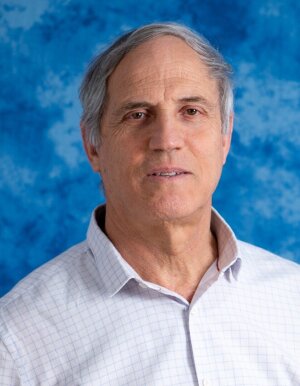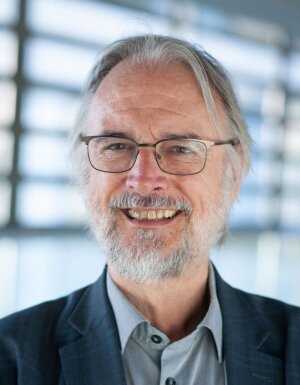- Light
Meldung vom:
Das Physikalische Kolloquium findet, wenn nicht anders angegeben, jeweils um 16:15 Uhr im Hörsaal 1 Abbeanum, Fröbelstieg 1 statt.
-
17.04.2023
Prof. Dr. Volker Schünemann, Fachbereich Physik, Rheinland-Pfälzische Technische Universität Kaiserslautern-Landau
Foto: privatGastgeber: Prof. Dr. Ralf Röhlsberger/Prof. Fr. Thomas Stöhlker
Complex chemical and biological systems under the magnifying glass of nuclear probes
Prof. Dr. Volker Schünemann
Technische Universität Kaiserslautern-LandauIron as a trace element is a prerequisite for life on our planet earth. Iron centers in proteins play an important role in the transport of small molecules, in the transport of electrons and as catalytically active centers. But also in chemistry iron plays a significant role due to its ability to cycle between different oxidation numbers and spin states.
The first part of this presentation will show how the nuclear probe 57Fe and Mössbauer spectroscopy as a magnifying glass can be used to investigate the electronic and dynamic properties of iron centers in proteins and in especially designed chemical systems like iron(II) containing spin crossover (SCO) materials. The spin state of SCO materials can be switched between the diamagnetic (S=0) and the paramagnetic (S=2) state. Therefore, SCO materials are interesting two-level systems for spin applications in devices and sensors. Spin dependent phonon density of states (pDOS) determined by synchrotron based 57Fe nuclear inelastic scattering (NIS) have been obtained for a deeper understanding of the role of phonons in these molecular switches [2].
The second part of this presentation deals with single molecule magnets (SMMs) representing another two-level system with potential spintronic applications. Dysprosium containing SMMs are among the best high-performance SMMs. For these systems the nuclear probe 161Dy can be used to obtain complementary information to conventionally applied magnetization measurement techniques [3]. 161Dy NIS experiments and accompanying density functional theory (DFT) calculations allow the identification of phonons responsible for unwanted under barrier spin relaxation [4].
[1] V. Schünemann (2021). From Small Molecules to Complex Systems: A Survey of Chemical and Biological Applications of the Mössbauer Effect. In: Yoshida, Y., Langouche, G. (eds) Modern Mössbauer Spectroscopy. Topics in Applied Physics, vol 137. Springer, Singapore; https://doi.org/10.1007/978-981-15-9422-9_4Externer Link
[2] T. Hochdörffer, A.I. Chumakov, H.-C. Wille, V. Schünemann, J. A. Wolny, Dalton Trans. 48, 15625 (2019); https://doi.org/10.1039/C9DT02139FExterner Link
[3] L. Scherthan, S. F. M. Schmidt, H. Auerbach, T. Hochdörffer, J. A. Wolny, W. Bi, J. Zhao, M. Y. Hu, T. Toellner, E. E. Alp, D. E. Brown, C. E. Anson, A. K. Powell, V. Schünemann, Angew. Chem. Int. Ed. 58, 3444 (2019); https://doi.org/10.1002/anie.201810505Externer Link
[4] L. Scherthan, R.F. Pfleger, H. Auerbach, T. Hochdörffer, J. A. Wolny, W. Bi, J. Zhao, M. Y. Hu, E. E. Alp, C. E. Anson, R. Diller, A. K. Powell, V. Schünemann, Angew. Chem. Int. Ed., 59, 8818 (2020); https://doi.org/10.1002/anie.201914728Externer Link
-
22.05.2023
Prof. Dr. Avi Comb, Hebrew University Jerusalem
Foto: privatGastgeber: Prof. Dr. Klaus D. Jandt
Prof. Dr. Avi J. Domb
Institute of Drug Research, School of Pharmacy- Faculty of Medicine
The Hebrew University of Jerusalem, IsraelBiopolymers - from the bench to the clinic
Biodegradable polymers have been used for absorbable sutures, orthopedic plates, and clips as drug carries and scaffolds for tissue engineering. These polymers are prepared from natural starting materials such as amino acids, hydroxy acids, and fatty acid that are connected by hydrolysable ester, peptide, or anhydride bonds. Biodegradable polymers are solids or injectable pastes that have applications as drug carriers and tissue augmentation. A new class of biodegradable polymers that change their properties or degrade on demand when applying light, temperature, hydrolysis conditions has been reported. Various absorbable implants have been developed in recent years, including biodegradable balloons for tissue separation, diagnostic markers, stents, and delivery systems.
Biodegradable constructs have been designed for use as drug delivery carriers, scaffolds for tissue engineering, temporary hard tissue replacements, and more. The synthesis and applications of absorbable polymers for medical use will be discussed.
-
12.06.2023
Prof. Dr.-Ing. Karlheinz Brandenburg
Foto: privatGastgeber: Fachschaft der PAF
Prof. Dr. Karlheinz Brandenburg
Brandenburg Labs GmbHFrom mp3 to PARty: How signal processing, psychoacoustics and machine learning fit together
The talk will start with a brief historical overview: How mp3 and other audio coding formats got developed. To advance this technology, a lot of knowledge about our ears has been necessary.
Since then, we have learned much more about our ears and brain, as well as how we listen to the world around us. Cognitive effects have become more and more important. We really hear what we expect to hear. All this has been used in a lot of research over the years.
Currently, an important topic of our research in Ilmenau is finding out how we can reproduce immersive sound, the feeling of “being there”, over headphones. After approximately 50 years of research by others and contributions from myself, we can finally claim that we have solved this problem. The process of how we achieved it and what means we used will be included in the talk.
The talk will conclude by presenting ideas about future applications that may initially sound like science fiction, such as PARty, but we are working to transform them into reality.


